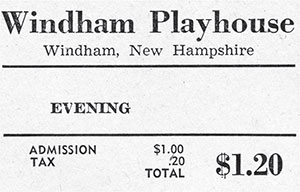
A 1946 regular admission ticket from the Windham Playhouse. Author’s collection .
17
CHICK AUSTIN’S PLAYHOUSE
Shortly after Everett “Chick” Austin was gifted the eighteenth-century home of Lieutenant Joseph Smith in Windham as a wedding gift from his mother, he delighted the residents of the town with a magic show. Although Austin’s performance in the town hall would have certainly paled in comparison to the feats of Houdini and history’s other great magicians, his charisma and talent for performing were able to hold the audience mesmerized for over two hours. This would not be the last time he was responsible for captivating the audiences of Windham and the surrounding locales.
Arthur Everett Austin Jr. was born on December 18, 1900, in Brookline, Massachusetts, to parents Dr. Arthur Everett Austin and Laura Etnier Austin. As his birthday was just a week shy of Christmas, Everett, as he was known to his family, grew up believing that the tinsel and other ornamental decorations of the season were for the celebration of his birthday rather than the holiday.
Because his mother was wealthy, young Everett was fortunate to have the opportunity to spend his childhood exploring Europe, although it appears this worldliness did not help him in his studies. His lackluster academic abilities made his acceptance to Harvard somewhat shocking. However, the school soon came to the realization that he was not cut from the same intellectual cloth as his classmates, and he was asked to leave.
Fortunately for Austin, a professor at Harvard took a liking to him and encouraged him to take part in George Reisner’s archaeological digs in Egypt and Sudan. The experience of recovering ancient art and relics in the sands of the desert spawned a love and appreciation of art in Austin. After returning from Africa, he went on to improve himself academically and received a degree from Harvard in 1924. Everett went on to become the director of the Wadsworth Athenaeum in Hartford, Connecticut. In this position, he was responsible for acquiring some of the greatest pieces of art in the museum’s collection today.
Not only did Austin bring many works by the Old Masters to the museum, but it was also under his direction that some of the earliest American exhibitions of the works of Pablo Picasso and Edward Hopper were organized. Although deeply involved in the art community, Austin began to become more and more interested in the theater. His involvement in the performing arts included magic, and he routinely performed as a magician at the Wadsworth Athenaeum. This interest in the performing arts would not fade during his lifetime.
After his experience with the receptive audience at the Windham Town Hall, Austin made the decision to convert the barn of his house in Windham into a summer theater. When the renovation was complete, the theater had seating for three hundred people, and the stage was more than adequate for the off-Broadway performances that would eventually be shown there. The box seats were brightly enameled sleighs that had been acquired over the years by Austin’s mother. Although Austin certainly had the expertise in theatrical performances to make the venture a success, the Windham Playhouse might never have become a reality were it not for the help of the community.
Most notably, Herbert and Rose Crucius were instrumental in the founding of the theater. Herb was given charge of routine maintenance and the stage crews, while his wife directed many of the other activities required to run the operation. Austin frequently even spent time at their home, eating whatever Rose happened to be baking and drinking coffee or eggnog; the eggnog was made by Rose especially for him to help his cough. Certainly many workers of the thirty-five-member crew were locals. Although their job took place behind the curtains, without them the show would have not gone on.
Being a member of the stage crew tasked with preparing the set and scenery would certainly have not been an easy job. Austin was notoriously a stickler for perfection and would not settle for anything less than the best. It is recorded that when a particular scene required a large oak tree, the crew was forced to venture into the nearby woods to locate and cut down the perfect tree. After the tree was felled, it was cut into movable sections and brought into the theater, where it was then reassembled with cables. The finished product was as close to an oak tree as one could have ever wanted.

A 1946 regular admission ticket from the Windham Playhouse. Author’s collection .
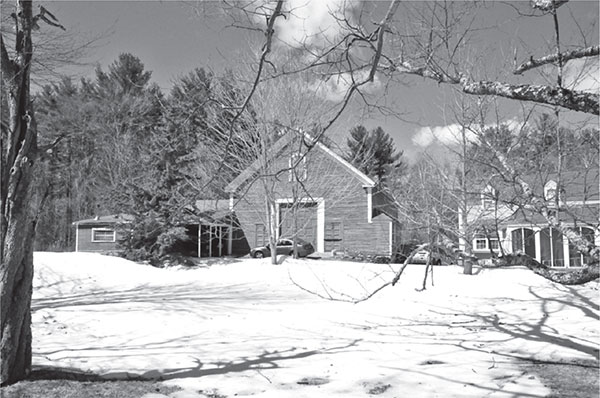
The barn that housed the Windham Playhouse. Mark Cantrell.
The detail of the scenery did not end there. It was not unusual for actual staircases and railings to be brought in to perfect the set. Though it would have taken a great deal of time to assemble such detailed sets, Austin did not shy away from designing as many sets as needed for a play. For one play, twelve different sets were constructed, each with its unique challenges for the crew. Some of the sets were nearly thirty-two feet high, and one even had flying scenery.
Such a level of perfection in scenery reflects the quality of shows at Austin’s theater. Although many of the shows opened to sellout crowds, the more popular of the shows drew more people than the barn could possibly hold; on some nights, as many as one hundred people had to be turned away. The lack of things to do in a small New England town and the quality of the productions made the $1.20 regular admission price a bargain for those interested in the theater or just looking for a couple hours’ entertainment. The plays also attracted well-known celebrities, such as Bette Davis, Richard Deacon, Lee Marvin and Rod Steiger. Though the plays themselves would certainly warrant the attendance of well-known performers, some of the stars might have been brought to the Windham Playhouse from the connections Austin had in the theater and art world.
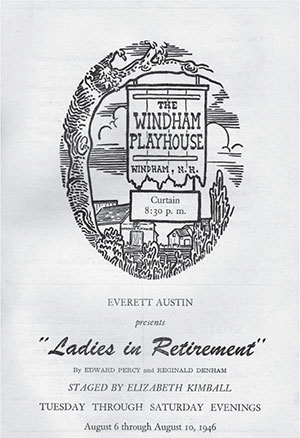
Program for Ladies in Retirement , one of the first shows at the Windham Playhouse. Author’s collection.
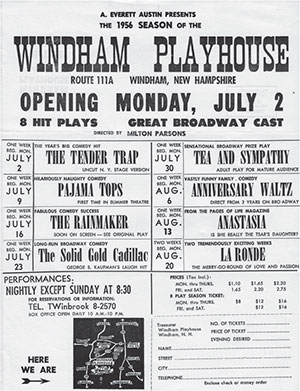
A 1956 Windham Playhouse flyer for the last season the playhouse operated under the direction of Chick Austin. Author’s collection.
The performers selected by Austin, especially toward the later seasons, were often seasoned professionals who were known to give highcaliber performances. Many of them came from New York, and their transportation, round trip, was provided to them as part of their contract. Housing was also provided to the performers, with three houses and a cottage on Cobbett’s Pond being used to accommodate the entire cast. With such amenities included, the fifty-five dollars paid to Lee Marvin for his first performance at the Windham Playhouse would have been quite an attractive offer. There was one drawback for the performers, though: the need and lack of water during the summer months. This problem was only exacerbated by a dry summer. Therefore, the cabin on the pond, with easy access to the pond for bathing, was always the most popular spot for the cast.
Austin would even join the cast on at least one occasion. In 1956, Austin played Prince Bounine in the play Anastasia . As with all the theater’s productions, attention to detail was not lacking in any way. Marble fireplaces and French doors were brought in for the scenery, and even antiques and photographs his mother had collected had begun to find their rightful place on the stage.
Shortly before the 1957 season opened, Austin spent his time traveling around the world, an interest he had developed as a child. Spending fall and winter abroad, Austin would return to Windham in the spring to begin to plan the upcoming season. Unfortunately, Austin was plagued by poor health for several seasons into his performances at the theater. Rather than travel the world, he made the decision to spend the winter in France while dedicating the rest of his time to Windham. Located near Austin’s theater and home was a cemetery, to which he gave a portion of his adjacent land in the summer of 1956, being sure to reserve a plot for himself, his wife and his children. He had also sketched Egyptian obelisks he intended to use as monuments for his family, perhaps a nod toward his days spent on archaeological digs in that country.
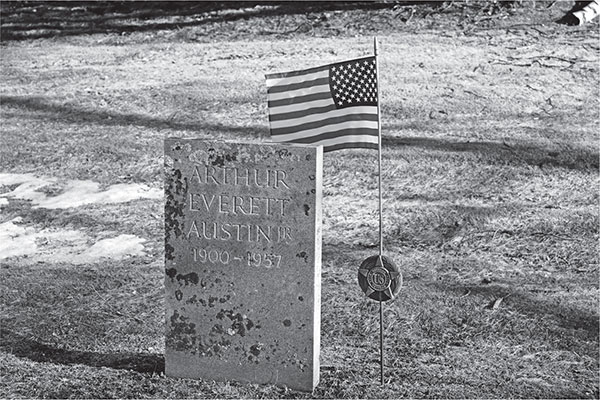
Chick Austin’s tombstone in Windham. The plain stone is very different from the obeliskshaped stone Austin had designed for himself. Mark Cantrell.
Not too much time was spent planning the future burial arrangements, as in March 1957, “Chick” Austin passed away at the age of fifty-six. Prior to his passing, Austin had been adamant about not having or wanting a will. When pressed with questions over his estate, he responded by saying it would have to be fought over. David Garmel took over as director of the Windham Playhouse for the 1957 season, but the settling of Austin’s estate necessitated the closing of the theater so the property could be sold. After an eleven-year run, the curtains at the Windham Playhouse closed for the last time.
Austin’s funeral was held on the first of April in Hartford, Connecticut. The following day, Austin’s body was brought back to Windham to be buried. The ceremony was small relative to the funeral, with only his immediate family and a few friends in attendance. As he had wished, Austin was buried on the plot of land he had reserved for himself and his family, his grave being dug by Herb Crucius. After the casket was lowered into the ground and the grave was filled in, a polished headstone of gray granite was placed at the site, instead of the obelisk Austin had wanted. When it was time to secure the stone to the cement foundation, Crucius struggled with the task, eventually using theatrical screws from the theater to ensure the stone would be a permanent fixture.